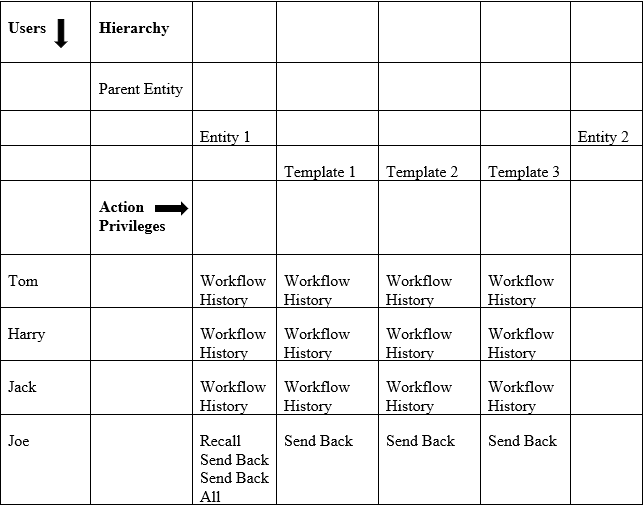- 9 Minutes to read
- Print
- DarkLight
- PDF
Entity Workflow
- 9 Minutes to read
- Print
- DarkLight
- PDF
Workflow Actions
Approval actions are based on approval role access.
| Budget Entity Approval |
Note: You can perform an Approve or Final Approve action without having to perform a Forward action first Note: You cant "send back" budgets with a "final approve" status. |
| Template Approval | Your admin may or may not have enabled the ability to Forward and Approve templates. If not enabled, you can mark templates as Mark Complete and Mark Not Complete after you input the data. If Forward and Approve is enabled, the following options will be available:
Note: You can perform an Approve action without having to perform a Forward action first If Forward and Approve is NOT enabled, the following options will be available:
|
Complete Workflow Tasks Associated with a Scenario
Admin users can configure this feature directly from the Planful application (refer to the Enable Enhanced Workflow section). Please note that once this functionality is enabled within your production environment, it cannot be disabled.
When a workflow process is started, tasks are created for users for every workflow step. You can view these tasks in Task Manager grouped under each scenario.
You can complete the workflow tasks (created by Admin users) associated with a scenario by following these steps:
Go to the Task Manager page. A new task is available for the same scenario that has been assigned to you.
Click the Expand icon near the Scenario Code to view all the tasks associated with that scenario.
For the Forward task associated with the required budget entity/template, under the Actions column, click Forward. The budget entity/template is forwarded and the Status of the task changes to Completed.
- You can complete the workflow actions from either the Task Manager, Planning Control Panel, Template Input pages or from the Offline Planning Template.
- You can perform workflow actions in one place; and the changes are reflected in all other places. For example, if a Forward task is completed from the Task Manager page, the status of the budget entity/template will be changed in the Planning Control Panel, and vice-versa.
- You can use the Planning Control Panel link to navigate to the budget entity/template on the Planning Control Panel page.
.png)
- If you also have access to Approve privileges, another task for Approve will appear. For the Approve task, under the Actions column, click Approvals. A list of options appears. You can perform any of the following actions:
- Click Approve. The approval of the budget entity/template is completed and the Status of the task changes to Completed.
- If the task is associated with a template, all the workflow tasks for that template are completed. If the task is associated with a budget entity, a new Final Approve task is created if the Final Approve action is enabled.
- If you want to send the task back to the previous state, click Send Back. The Approve task is deleted from the list of tasks and the status of the Forward task for the budget entity/template changes back to In Progress.
- For the Final Approvetask associated with a budget entity, you can perform any of the following actions:
- Click Final Approve. The final approval of the Entity is completed and the Status of the task changes to Completed.
- If you want to send the budget entity back to the previous state, click Send Back. The Final Approve task is deleted from the list of tasks and the status of the Approve task for the Entity changes back to In Progress.Note:You cannot send back a task after the final stage of its associated budget entity/template has been completed from the Task Manager page. You can, however, perform this action from the Planning Control Panel page.
Recall Templates/Budget Entities after Forwarding, Approval, and Final Approval
This functionality is now enabled by default for all new and existing customers.
The Recall option is only available for users who have performed an action on a template/entity until the template/entity has not been moved to the next stage by another user.
For example, let us consider that you have forwarded a Workforce Planning template and want to recall it to make some changes. You can recall the template until it is not approved by another user. Once the Workforce Planning template has been approved, you cannot recall it.
Go to the Planning Control Panel.
Select a scenario, a budget hierarchy entity member, and a template that you have forwarded as shown in the image.
Click Recall.
The template is moved to an In progress state.
Note:When you Recall an entity, this action is a “smart” undo; because this action truly reverses the action that you previously performed. Consider an example where you selected an entity that has 5 templates within it; template 1, 2, and 3 have been forwarded by another user. If you then Forward the entity, this action will forward the remaining templates (4 and 5). If you perform a Recall action, only the entity and templates 4 and 5 are moved back to an In Progress state. The state of templates 1, 2, and 3 (which were forwarded by another user before you performed the Recall action) will not be changed.Note:The Recall option is also applicable for approved/final approved entities and for approved templates.
Availability of Send Back and Recall options for users
This table lists the availability of Send Back and Recall options for users who have the following approval actions for a budget entity.
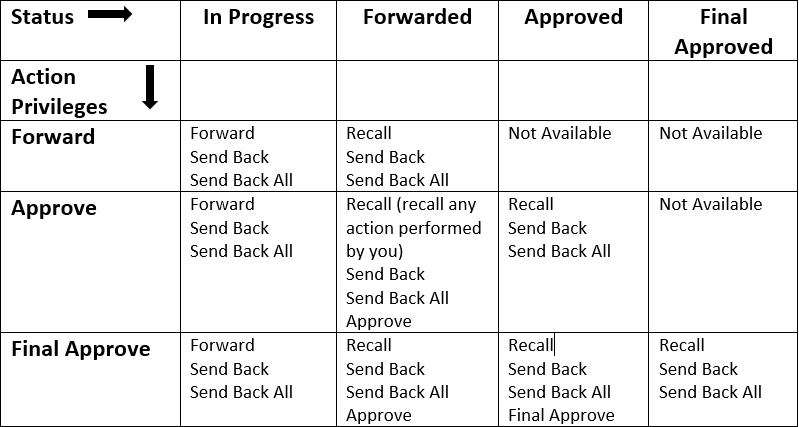
The following example explains in detail the behavior of both the Recall and Send Back options:
Hierarchy:
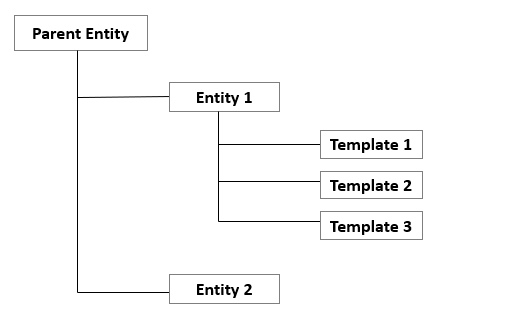
List of users with Approval actions:
Joe has Final Approve permissions for Parent Entity, Entity 1, and Entity 2.
Jack has Approve permissions for the entire hierarchy.
Harry has Forward permissions for all the entities and templates; for example, Entity 1 (Template1, Template 2, and Template 3) and Entity 2.
Tom has Forward permissions for all the entities and templates; for example, Entity 1 (Template1, Template 2, and Template 3) and Entity 2.
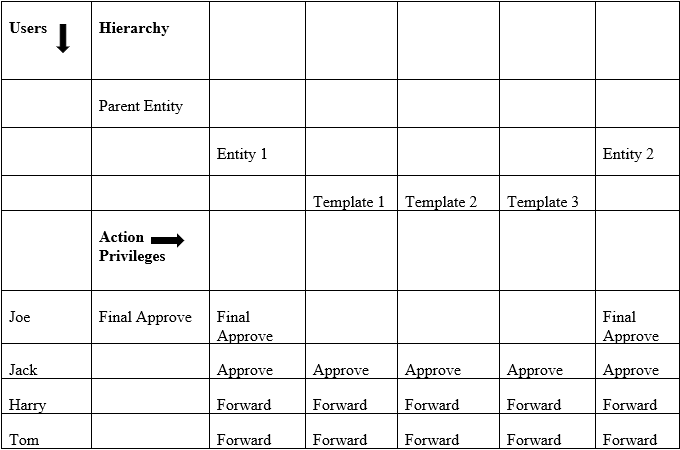
If Tom forwards Template 1, he can view the Recall option for Template 1.
Harry can view the Send Back option for Template 1.
Jack can view the Approve and Send Back options for Template 1.
Joe can view the Approve and Send Back options for Template 1.
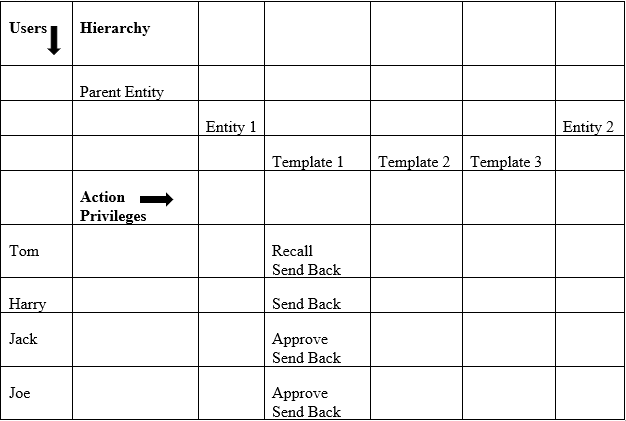
If Harry then forwards Entity 1, Template 2 and Template 3 are also forwarded.
Harry can use the Recall option for Entity 1, and this action will move Entity 1, Template 2, and Template 3 to an In Progress state.
Harry can also use the Send Back option for Entity 1, Template 1, Template 2, and Template 3; if he wants to move either of these artifacts to an In Progress state and not the entire Entity 1 hierarchy.
Tom and Harry can use the Send Back All option for Entity 1. This will send back Entity 1 and all its artifacts (Template 1, Template 2, and Template 3) to an In Progress state.
Tom can use the Send Back option for Template 2 and Template 3.
Jack can use the Approve , Send Back , and Send Back All options for Entity 1.
Jack can move Entity 1 and all its artifacts (Template 1, Template 2, and Template 3) to an Approved state by using the Approve option.
Jack can move the Entity 1 to an In Progress state by using the Send Back option.
Jack can move Entity 1 and all its artifacts (Template 1, Template 2, and Template 3) to an In Progress state by using the Send Back All option.
Jack can also use the Send Back option explicitly for Template 1, Template 2, and Template 3.
Joe can use the Final Approve , Approve , Send Back , and Send Back All options for Entity 1. Joe can also use the Send Back option explicitly for Template 1, Template 2, and Template 3.
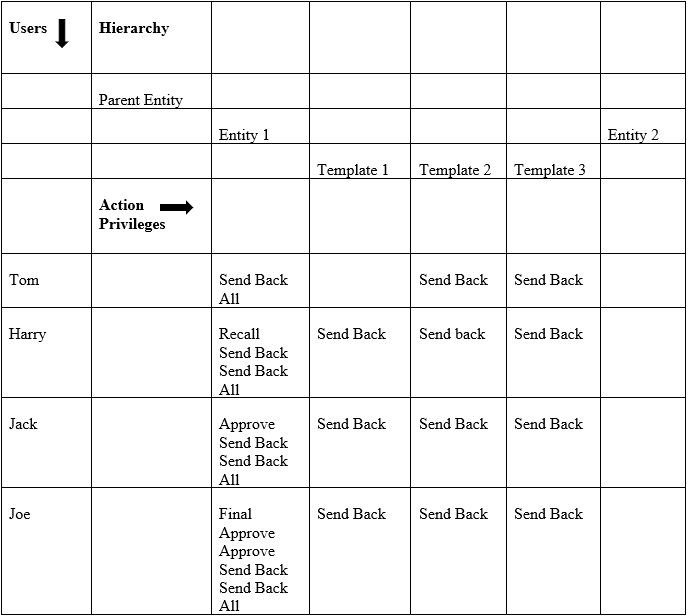
Now if Jack approves Entity 1, Entity 1 and all its artifacts (Template 1, Template 2, and Template 3) are moved to an Approved state.
Jack can use the Recall option for Entity 1 to move Entity 1 and all its artifacts (Template 1, Template 2, and Template 3) back to a Forwarded state.
Jack can use the Send Back All option only for Entity 1. He can also use the Send Back option explicitly for Entity 1 and each of its artifacts (Template 1, Template 2, and Template 3).
Joe can use the Final Approve, Approve , Send Back, and Send Back All options for Entity 1. Joe can also use the Send Back option explicitly for Template 1, Template 2, and Template 3.
Harry and Tom can only use the Workflow History option in this scenario.
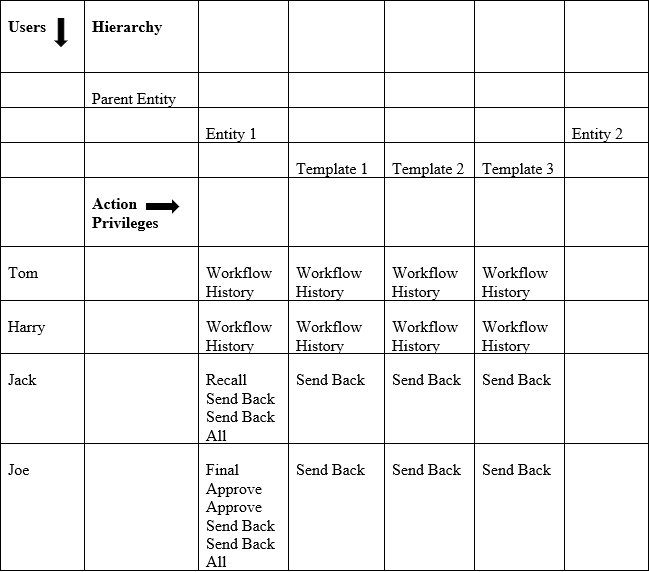
If Joe then final approves Entity 1, Entity 1 and all its artifacts (Template 1, Template 2, and Template 3) are moved to a Final Approved state.
Joe can use the Recall option for Entity 1 to move Entity 1 and all its artifacts (Template 1, Template 2, and Template 3) back to an Approved state.
Joe can use the Send Back All option for Entity 1. He can also use the Send Back option explicitly for Entity 1 and each of its artifacts (Template 1, Template 2, and Template 3).
Harry, Tom, and Jack can only use the Workflow History option in this scenario.
